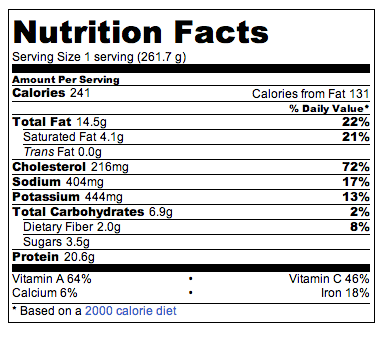Happy National Bacon Lover’s Day!
To help you celebrate I’ve got an awesome BLT style frittata recipe that is absolutely delicious (I've made it twice already!)

First though, in honor of National Bacon Lover’s Day, let’s take a look at America’s most beloved food in search of the answer to the greatest debate, “Can bacon be part of a healthy diet?” Let’s find out...
Bacon manufacturers would love to have you believe it’s the “other white meat.” Recent research has indicated it might not be as bad as once thought. Let’s look at the nutrition breakdown-
Per one ounce of bacon (1-2 slices):
- 151 Calories
- 12 grams Total Fat of which about 50% is Monounsaturated Fat, 40% is Saturated Fat, and 10% Polyunsaturated Fat.
- 10 grams of Protein
- 30mg of Cholesterol
- 200mg or more of Sodium (depending on manufacturer)
- Good source of Niacin and very good source of Selenium
As a former, anti-bacon advocate, when I started looking into it I became overwhelmed with the information regarding whether bacon can fit into a healthy diet or not.
What are the concerns?
- High saturated fat content may increase the risk of heart disease by increasing blood levels of cholesterol.
- High sodium content may increase risk of high blood pressure, thereby increasing risk of heart disease.
- Nitrate and Nitrosamines used in the curing process may contribute to increased risk of certain types of cancer.
- Carcinogenic compounds (such as PAHs- polycystic aromatic hydrocarbons and HAs-heterocyclic amines ) are formed by over-cooking and charring meat are linked with certain types of cancer.
- Processed meats in general are associated with higher risk of chronic disease such as heart disease, cancer, and diabetes.
What does current research say?
Saturated Fat
Saturated fat intake may not be the most important predictor of heart disease as once thought. A large meta-analysis recently found no correlation between intake of saturated fat and heart disease (1,2). When replacing trans fat (think partially hydrogenated oil, crisco etc.), saturated fat has been found to raise both LDL (bad) and HDL (good) cholesterol (3), thereby not affecting the ratio of good to bad, which may be a more important factor at predicting heart disease than overall cholesterol.
Sodium
The general population is consuming far more than the recommended limit of sodium via convenience foods such as fast food and highly processed pre-packaged foods. While sodium is a vital nutrient for muscle contractions, nerve transmissions, and maintenance of pH balance as well as hydration, too much is associated with increased risk of high blood pressure (4, 5) The sodium content of bacon, therefore, may be a concern for those who already have high blood pressure or have other risk factors for heart disease such as a family history.
Nitrates-->Nitrosamines
Since the link between nitrates and cancer, most manufacturers have begun adding ascorbic acid (Vitamin C) during the curing process. The addition of Vitamin C can block the formation of nitrosamines, a known carcinogen (6,7). Bacon and other meats also come uncured, which is my preferred way to buy them.
Other Carcinogenic Compounds
I wrote about ways to reduce the formations of these compounds in this post on grilling. Unfortunately, fried bacon contains more heterocyclic amines than any other meat (8). You can try baking it, but that recently ended in disaster for me, or just not frying it till black.
Processed Meats and Cancer
The association between processed meat, red meat, and chronic disease were primarily my motivation for avoiding bacon in the past. (I used to eat no red meat AT ALL, you can see my post explaining it here.) Studies have found an association between processed meat and certain types of cancer (9), heart disease and diabetes (10).
The biggest cited criticism here is that these studies are only associations and not clinical trials. This means people who eat a great deal of processed meat may also be more likely to lack physical activity, eat more highly processed other foods like refined carbohydrates and trans fat, as well as drink alcohol and smoke. These studies, although taken with a grain of salt, probably shouldn’t be completely ignored. There is still the link of processed and red meat with carcinogenic compounds from the curing process or naturally occurring to be considered.
Take Home
What’s the take-home message from an RD’s perspective? Everything in moderation! Bacon can occasionally fit into a whole food diet, which includes lots of antioxidant-rich plants like vegetables, fruits, and nut/seeds etc.
I say occasionally because it is still a processed food and there are better, less risky protein options out there (chicken, fish, tofu etc.). You may also want to limit your consumption if you already have predisposing health conditions such as high blood pressure, diabetes, or other concerns. That being said, let’s celebrate America’s obsession with bacon with a lightened up BLT Frittata recipe!
BLT Frittata

National Bacon Lover’s Day
Ingredients
- 3 Large Tomatoes sliced
- 3-4 pieces of cooked bacon chopped (depending on the thickness level- I used 3 Pieces of Trader Joe’s Applewood Smoked Uncured Bacon)
- 2 cups Micro Greens can be bought at TJ’s, or sub spinach
- 1 large green onion chopped
- ¼ teaspoon dill
- ½ cup chopped parsley
- 5 eggs
- 1.25 cup egg whites
- 1 garlic clove minced
- ¼ teaspoon salt
- ¼ teaspoon garlic
- ¼ teaspoon pepper
- 1 T avocado oil or EVOO
Instructions
- Cook bacon according to package directions.
- Preheat Oven to 350F & place an oven safe skillet over medium heat
- Whisk eggs, egg whites, and seasonings (salt, garlic, dill, and pepper) in a medium bowl. Set aside.
- Add onion and minced garlic to the pan, sauté for 1-2 minutes until soft.
- Add micro greens and parsley to pan and sauté until wilted about 1-2 minutes.
- Whisk eggs again to ensure combined and add to pan, then add bacon. Stir briefly to ensure it is combined with greens. Finally top the mixture with tomato slices.
- Place skillet in oven for 25-30 minutes until fully set and slightly browned on top.
- Let cool at least 5 minutes and serve!
Nutrition
Makes four servings-
Enjoy and let me know if you try it!
Resources:
1. Siri-Tarino, P. W., Sun, Q., Hu, F. B., & Krauss, R. M. (2010). Meta-analysis of prospective cohort studies evaluating the association of saturated fat with cardiovascular disease. The American journal of clinical nutrition, ajcn-27725.
2. Siri-Tarino, P. W., Sun, Q., Hu, F. B., & Krauss, R. M. (2010). Saturated fat, carbohydrate, and cardiovascular disease. The American journal of clinical nutrition, 91(3), 502-509.
3. Hunter, J. E., Zhang, J., & Kris-Etherton, P. M. (2010). Cardiovascular disease risk of dietary stearic acid compared with trans, other saturated, and unsaturated fatty acids: a systematic review. The American journal of clinical nutrition, 91(1), 46-63.
4. Pietinen, P., Uusitalo, U., Nissinen, A., & Intersalt Cooperative Research Group. (1988). Intersalt: an international study of electrolyte excretion and blood pressure. Results for 24 hour urinary sodium and potassium excretion.Bmj.
5. O'Donnell, M. J., Yusuf, S., Mente, A., Gao, P., Mann, J. F., Teo, K., ... & Schmieder, R. E. (2011). Urinary sodium and potassium excretion and risk of cardiovascular events. Jama, 306(20), 2229-2238.
6. Tannenbaum, S. R. (1988). Preventive action of vitamin C on nitrosamine formation. International journal for vitamin and nutrition research. Supplement= Internationale Zeitschrift fur Vitamin-und Ernahrungsforschung. Supplement,30, 109-113.
7. Hu, J., La Vecchia, C., Morrison, H., Negri, E., & Mery, L. (2011). Salt, processed meat and the risk of cancer. European Journal of cancer prevention,20(2), 132-139.
8. Tannenbaum, S. R. (1988). Preventive action of vitamin C on nitrosamine formation. International journal for vitamin and nutrition research. Supplement= Internationale Zeitschrift fur Vitamin-und Ernahrungsforschung. Supplement,30, 109-113.
9. Puangsombat, K., Gadgil, P., Houser, T. A., Hunt, M. C., & Smith, J. S. (2012). Occurrence of heterocyclic amines in cooked meat products. Meat science, 90(3), 739-746.
10. Micha, Renata, Sarah K. Wallace, and Dariush Mozaffarian. "Red and processed meat consumption and risk of incident coronary heart disease, stroke, and diabetes mellitus a systematic review and meta-analysis."Circulation 121.21 (2010): 2271-2283.









Emily @ Zen & Spice says
I've always been a fan of bacon but try to just eat it occasionally. It's a great treat and I think it can definitely fit in with a whole foods plan!
Kelli Shallal MPH RD says
Yes, it's definitely a salty crunchy treat.
Meme says
mmm mmm mmm! Bacon is my absolute favorite thing, but I try not to eat it too often {and eat too much}. This BLT looks delish!!
Kelli Shallal MPH RD says
You'll have to try it out for National Bacon Lover's Day 😉
Rachael@AnAvocadoADay says
Being in the South, I like to use a slice of bacon to flavor vegetables every once and awhile. We get a really yummy organic bacon from the farmer's market! My clients get really excited when I tell them it's not the worst thing in the world - I mean, a fourth of a slice of bacon in your green beans isn't the end of the world!
Kelli Shallal MPH RD says
Well said! It's the double bacon layered deep fried deluxe that will get you in trouble! I was raised by a Southern Woman and bacon was a BIG part of my childhood... and SPAM. LOL
Mary @ flavorrd says
Great post!! It's really not easy to dive into the research and tie it together into a cohesive message. The message is spot on, and the recipe looks amazing... I'm all about the fresh dill and parsley!
Kelli Shallal MPH RD says
Thanks I'm glad you thought so!